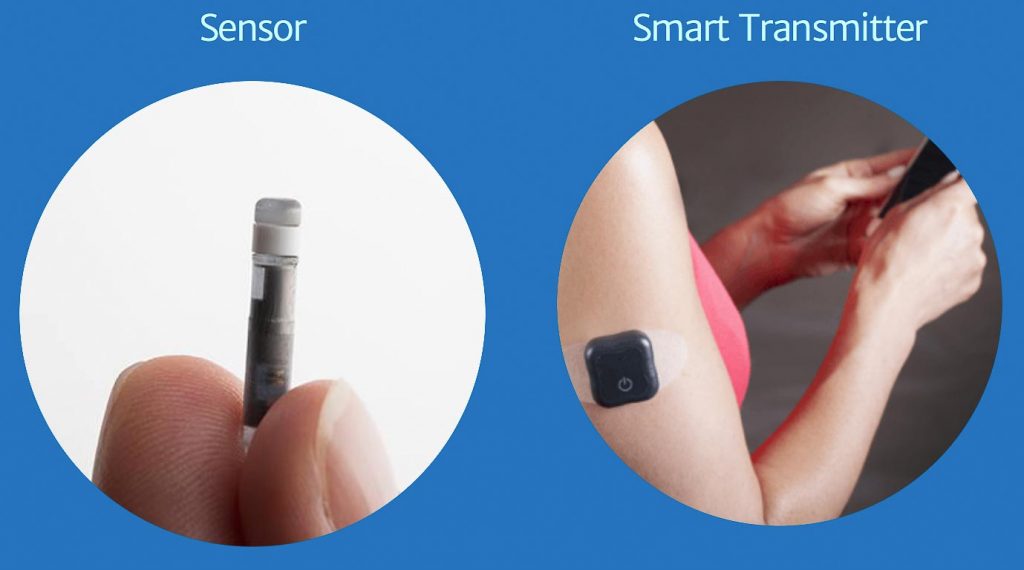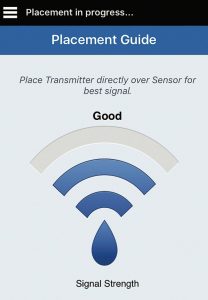As people living with chronic conditions we build up real-world experience that it sometimes seems device manufacturers don’t have and don’t take advantage of. This is probably sometimes true, although we might sometimes just be expecting too much.
I came across some examples recently during my time in the UK, relating to the new Eversense CGM. Note that this is not approved for use in Australia, and I’m not aware of any plans to introduce it. But it is an interesting device nonetheless.

This system has a small sensor which is implanted under the skin by a doctor (through a 5-8mm incision involving local anaesthetic) where it stays for up to 90 days (or 180 days for the Eversense XL). A special transmitter is stuck onto your skin above the sensor, and that communicates with your phone via Bluetooth. Transmitter systems like this will be familiar to anyone who uses FreeStyle Libre sensors with Nightrider, M-Transmiter, or SmartWatch 3 devices to transmit CGM data to a phone.
Wow factor
Selling points of this system seem to include its accuracy, and that you don’t have to restart the CGM sensor every week and continually jab yourself with sensor needles. They certainly seem to have tried to make it “sleek and sexy”. If you’re away from your phone, the transmitter can still alert you to highs and lows via vibration.
Questions
However for people like myself who live with technology systems like this day-in-day-out, some questions do fairly quickly spring to mind. Note that I have not used this system myself. However I have heard feedback from friends who have been trialling the system. So I suppose this is a review/critique of a product I haven’t actually used. But I’ve seen some people get excited at news of it, and worry they might not be considering all the angles. So here are some of my questions that have arisen.
Illumination
I think a reasonable summary of the way the sensor works is that the glucose in the body binds to receptors on the sensor in a reversible fashion (unlike many other CGM sensors where a substrate is gradually used up by the glucose). This is how the sensor can last so long. The level of glucose on the sensor is then measured using a tiny LED and an optical sensor, and then retrieved by the transmitter above.
Sounds like an interesting approach, until you realise that it’s not dark inside the body. Especially not just under the skin where this sensor is installed. When you hear of people walking around on a European winter’s day wearing several layers of clothes experiencing “high ambient light” errors from the system (with no CGM data as a result) you wonder if this product would ever have a chance of working in an Australian summer or the Middle East!
 The European website promoting the Eversense CGM shows us this image of someone wearing it. The cynic in me does wonder if this model actually had a sensor underneath the transmitter and whether it was actually producing results at the time of this photo!
The European website promoting the Eversense CGM shows us this image of someone wearing it. The cynic in me does wonder if this model actually had a sensor underneath the transmitter and whether it was actually producing results at the time of this photo!
Transmitter glue
The glossy sales material says the transmitter is attached “with acrylic-based adhesive patch that is replaced daily”. The manual describes it as a silicone adhesive. Having experienced skin irritation with a variety of bandages that needed to be replaced daily, I do wonder how the skin will bear up after a new adhesive in the same place every day for 90-180 days in a row. Hopefully they have put a lot of research into this.
Water resistance
The transmitter is only water resistant down to 1 m for up to 30 minutes. This is the same as the Libre sensor, although my own experience is that the Libre’s water resistance can be improved by the use of Tegaderm tape. I must say (from my experience with Libre and transmitters, and with Dexcom G5) that wearing a fully waterproof CGM sensor/transmitter really does help with just getting on with the rest of your life without the disruption of taking it off (or worrying if you’ve just dived too deep in the swimming pool).
Recharging
The transmitter needs to be removed for about 15 minutes each day to be recharged. Having had a rechargeable Libre-based setup that needed to be recharged daily, I know from experience that is quite disruptive compared to having a transmitter on my arm that only needs batteries serviced after weeks or even months of use. I was actually able to connect a USB cable to recharge that SmartWatch3 system without having to remove it from my arm (which was useful if I was sleepy but still wanted the CGM to work, or had a USB battery in the pocket of my jacket towards the end of a long day).
The charging points on the Eversense transmitter are only accessible after removing it from your arm. At least the recharges are quick, and for example can be done while you shower before you re-attach the transmitter with new adhesive.
Placement
 The transmitter needs to be installed directly over the sensor (the phone app guides you to the place with the best signal strength). Even rotating the transmitter slightly can reduce the signal signal strength.
The transmitter needs to be installed directly over the sensor (the phone app guides you to the place with the best signal strength). Even rotating the transmitter slightly can reduce the signal signal strength.
Whether I’m using a Libre-based or Dexcom G5 CGM, every few weeks I install a new sensor (usually alternating arms). But exactly where I place it can have a big effect on how much I will notice the sensor. I try to position them on the back of my upper arms, tucked in towards my body slightly. This way they’re protected from bumping into things (it’s amazing just how close we’re used to walking to doorways for example). And if I lie on either my back or my side in bed, the sensor isn’t being squashed (which can be uncomfortable as well as resulting in “compression lows” where the localised glucose concentration around the sensor gets reduced, causing false low reports). Occasionally I have installed a sensor in not quite the best position, and have had to sleep awkwardly for the next two weeks. Through trial and error you soon learn the optimal locations. Even a change of 5mm across can make a big difference.
Now consider a system where the transmitter needs to be in the same place (with new tape applied every day) for 3 or 6 months at a time. If the doctor didn’t happen to install the sensor in just the right position to suit your body and your sleeping habits, you’ve got months of discomfort to look forward to. In fact it could be years until you can identify the optimal location for your body, even with a cooperative doctor! This is apparently not just a theoretical concern: it has been raised in conversations by other people than just me.
Even after alternating arms and coming back after 6 months, I do wonder how far away the next incision on that arm needs to be. Once you’ve finally found a “perfect” spot, will you be able to re-use it?
Design in the real world
Looking from the outside, I really have the feeling that issues like this are often not explored fully by the design teams working on these products, and how often these issues end up on the pile of “implementation issues for someone to work out later”. It would be interesting to know how many of the designers have actually worn products like this and used them non-stop for months on end (as well as using alternate products so they have reference points). This observation applies to more than just this one example product of course: I’m not especially picking on the Eversense CGM!
The Eversense is definitely an interesting development, although accuracy and precision of the numbers that come out of a CGM are not the only measure of how good it is. I look forward to future systems that can build on it.

Thanks for walking me through a number of those ‘side’ issues, David. Once again a bit of good clear thinking in amongst the hype. BTW one of our HypoActive members has trialled it and loved it, however I’m less sure that I want another scar every 3 months, let alone the risk of another potential infection site!
A 5-8mm insiscion is bound to leave scars. In particular on diabetics with altered healing. And thise who develop keloid scar tissure Not sure that this is ideal.
Thanks David. I did trial the Eversense (not XL) in late February last year. Unfortunately i personally didn’t like it, the insertion process although small 5-8mm, it is an invasive surgery. Not many Endo’s have picked up any surgical tool since med-school, so this is a huge limiting factor for its uptake in Europe. 12months on – I do have a significant scar. And during the wearing of the sensor – it was not very comfortable, its quite a big lump beneath the skin – very sensitive to pressure and movement. Glad to see you note the ambient light issue – In Korea or Europe (under clothing) didn’t have many issues – however back home in Australasia – sunlight caused many ambient light warning alarms…